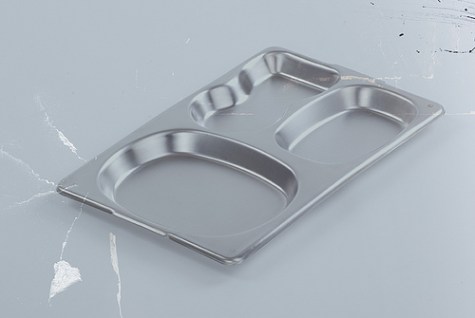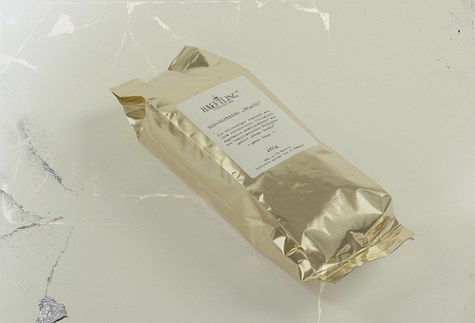
Reading the Goethe-Institut Fashion Scene article about Haeftling designers in Berlin, I thought it was an Onion style send up. “Prisoner chic” sounds like something straight out of satire, but I guess I was snoozing when this hit the news wires in 2003.
Haeftling (translated as ‘Prisoner’) employs inmates across Europe to manufacture clothing and housewares inspired (they say) by prison life, “The garments are highly functional and have a classic and timeless cut. Only high-grade, rugged fabrics are used in manufacturing.”
Well, whatever you say. I actually don’t mind how they market it, I am just pleased they support prison reform, the abolition of the death penalty, political prisoners rights and a philosophy of rehabilitative justice.

Haeftling Tray
But let’s not kid ourselves. This project was borne of commercial interests. “It began in the JVA (Justizvollzugsanstalt/prison) Tegel and developed into an international undertaking. More and more prisons have joined and today production is even taking place elsewhere in Europe. One Bavarian prison supplies honey from its own two colonies of bees; a prison in Switzerland even has its own vineyard and exports its own red (Pinot Noir) and white wine (Müller Turgau).” (source)
Karola Schoewe, Haeftling’s PR & communications manager says, “On the whole, the prisons are all very helpful,” says “There are some prisons that have very good production capacities for making homeware.”
Schoewe then marries the business speak to social responsibility speak, “Through its production, Haeftling is creating measures that help to support rehabilitation processes.”

Haeftling Espresso
Without seeing Haeftling’s account-books or sitting in on a board meeting, I have no way to tell if resources and profits are divvied up in a way that benefits prisoners more then in the state run prison industries. This was the situation in July 2003
(Author’s Note: €12.50 is substantial pay compared to American prisons.)
Prison industries are a divisive issue. For some they are the perfect use of prisoners’ time and energies developing job skills, work community & self-esteem. To others prison industries are a modern slave labor exploiting societies’ self-created incarcerated class.
Both viewpoints have legitimacy, but the first makes a prior assumption that could be misleading – that work programs are the only means to provide skills, community or self-worth. Education does this too.
But educating someone instead of putting them to work is going to cost a prison authority rather than generate it wealth.

Generally, I am unnerved by the disconnect between the reality of incarceration and its representation to consumers,
Then again, Klaus-Dieter Blank, of Berlin’s Tegel Prison states the success of the label’s online store has meant that people are beginning to understand “what goes on behind the walls”. Haeftling features on the Tegel Prison website.
Is there too much space here for consumers to create their own version of prison life? What is included and/or played down in the minds of consumers? Are they being coerced and sold a disingenuous view along with that ‘rugged’ product?

"Justiz 82" Scratchy Blanket. Haeftling Product
We can assess this a number of ways – rehabilitative worth, public awareness worth, benefits to state finances, tax-payer savings, external benefits of development in social entrepreneurship.
But essentially, we must ask, “Does this enterprise help reduce prison populations by reducing recidivism? It MUST be compared to other rehabilitative programs. The purpose of prisons the world over should be to create societies where prisons are no longer necessary.
How do you judge this type of enterprise?

3 comments
Comments feed for this article
June 18, 2009 at 8:32 pm
blaark
I think they incriminate themselves as heartless opportunists when they start selling the prison image… If it was more innocuous clothing then perhaps it is worthwhile for everyone involved; I would prefer all profits go to prisons, prisoners and preventative programs but I’m not going to argue the abilities of government programs vs. private… The point is a big part of their image is prison and capitalizing on that is just a lob of gob in the face of the captive work force making the wares… I don’t care what the benefits are in the end when the cost is that…
June 21, 2009 at 5:10 pm
Sven
very fascinating post, Pete. It’s like the Alcatraz prison tourism industry, only that this is actually making profit off of actual inmates rather than a romanticized former high security prison with a view and former prisoners posing for the camera and selling T-Shirts. Another great expose to which there probably is no clear right or wrong answer. Is it glorifying prison or is it bringing much needed attention to the fact that prisons exist and are filled with people? My take is that it’s probably a wash, this is probably neither helping to address the core roots of the problem nor pouring gasoline on the fire. At any rate, more interesting and artistically pleasing than Flomax commercials, so I’ll give it a go here…
April 15, 2010 at 12:45 pm
Carceral Chic « threadbared
[…] As Pete Brooks at the amazing Prison Photography observes, “Prison industries are a divisive issue. For some they are the perfect use of […]